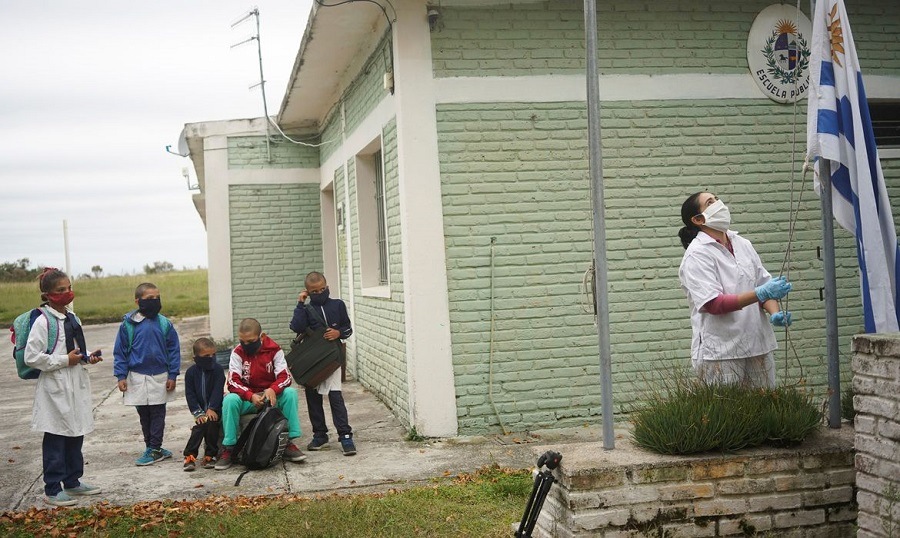RIO DE JANEIRO, BRAZIL – When the coronavirus pandemic broke out, Uruguay was among the countries of greatest concern, since 14 percent of the 3.5 million Uruguayans are over 65 years of age (25 percent are over 55) and many people were at risk from the disease.
Despite this risk, the country has succeeded in flattening the infection curve, mortality is low, and the number of people infected is decreasing. Most surprisingly, they have achieved this without the need for compulsory quarantine.

With 738 cases detected, 20 dead and 579 recovered from Covid-19, according to official figures released on Tuesday, this small country of 3.4 million inhabitants is now heading towards the almost total opening of activities.
The authorities’ optimism is based on encouraging figures. By Tuesday, only 139 people were affected by the disease, and the number is tending to decline: it was 209 in late April.
The reproduction rate of the virus (R0), which determines how many others each patient or carrier infects, stood at 0.74 on Tuesday in Uruguay, according to a model developed by engineer Andrés Ferragut and mathematician Ernesto Mordecki, members of one of the groups working under the government’s advisory committee.
Does this mean that the virus will disappear in the country? “In an ideal world, yes,” Ferragut told AFP, before clarifying that the number is dynamic and updated every day. “It depends on many things: on the natural infectivity of the virus, but also society’s behavior and the measures in place,” he adds.
China’s initial estimate, he recalls, was that each person infected an average of 2.5 others, “which led to alarm because it results in an exponential increase.” But in Uruguay, that figure not only never replicated, but the experts advising the government speak of a “seemingly low prevalence” of the virus and a “containment” of the epidemic.
According to the EndCoronavirus.org website of the New England Institute of Complex Systems in Massachusetts, United States, Uruguay is one of 43 countries in the world, and the only one in South America, that is “winning” the battle against the virus.
Can there be a catch in the numbers? Epidemiologist Julio Vignolo, a member of the expert committee advising the government, says there is not.
“You could tell me there’s underreporting, but more and more tests are being done. And whoever doesn’t believe in the tests, then how do you explain that the ICU (Intensive Treatment Centre) beds are free? Why aren’t the health systems overcrowded? Why isn’t there an increase in mortality? You can’t hide that,” he tells AFP.
In his opinion, “it is a fact” that the epidemic “is under control” in Uruguay, considering the low mortality rate (2.7 percent) as well as the decrease in active cases and new infections.
Among the reasons for the success, Vignolo points to the speed of response. Uruguay detected its first four coronavirus cases on March 13th, and on that same day, the government declared a health emergency, suspending classes and closing its borders within hours, among other measures.
It also called for the population’s voluntary confinement, which people complied with on a massive scale. According to a report by Google Mobility, a platform that reports on travel in different communities, on March 29th, activity in recreational venues such as cafes, theatres, and shopping malls had been reduced by 75 percent, and in parks, squares, and beaches by 79 percent.
The country’s demographic features, with a low population density and no large cities, also contributed.

As the southern hemisphere winter approaches, Uruguay is experiencing a decline in other respiratory diseases, which is “logical” considering social distancing, hand-washing and use of masks by the population, Vignolo says.
The government’s confidence in its results is such that President Luis Lacalle Pou is expected to announce the resumption of primary school classes on Thursday, joining other sectors that have made their way into the so-called “new normality.”
But there are those who caution against excessive confidence among the population, which has been relaxing its voluntary isolation. In fact, the latest report from Google Mobility, dated May 9th, shows that the decrease in mobility in cafés and shopping malls has dropped to 36 percent, and in parks and squares, to 53 percent.
“We must not indulge in triumphalism. This is a daily occurrence. We must be prudent, cautious,” explains Vignolo.
“The coronavirus is here to stay. And tomorrow cases may get out of control because people are starting to gather,” he says, before stressing that the battle against Covid-19 “is going to be a long one. It will continue “until there is a solution in place,” he says.
This could be an example for several countries in the continent, such as Brazil and Ecuador, which have seen their health systems collapse due to an exponential increase in infections.
Source: AFP

